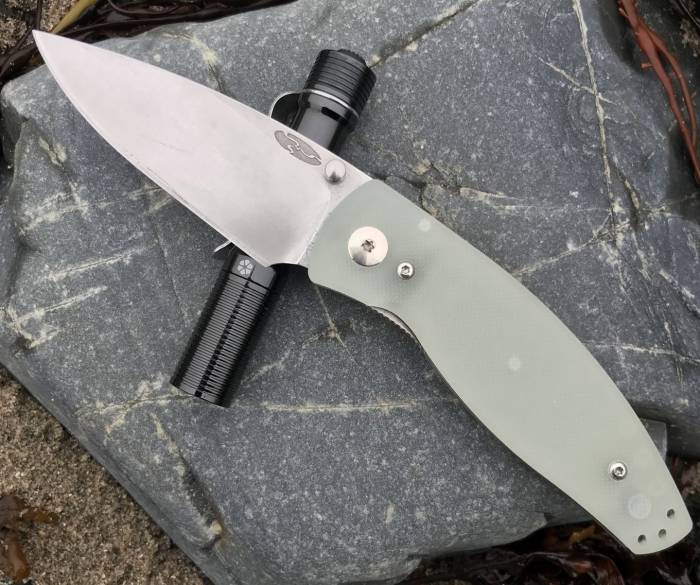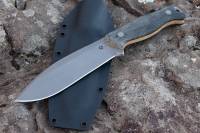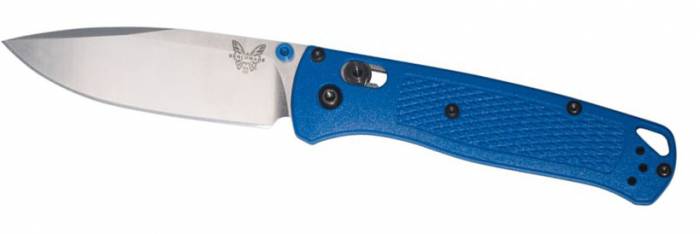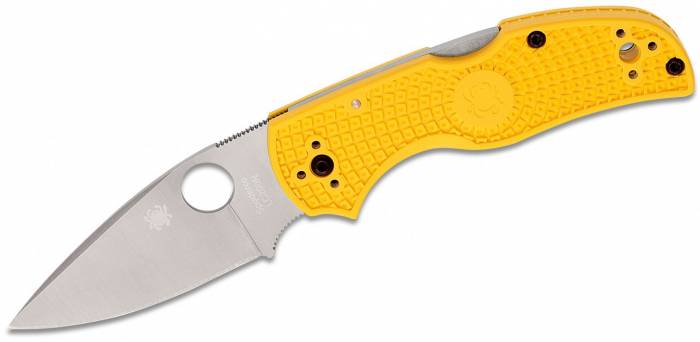The Best Knives for Hiking & Backpacking of 2022
Hikers want a light, reliable, and versatile pocket knife for use on the trail. Below, we’ve rounded up the best knives for backpacking and hiking.
Summer is here, and if you listen closely you’ll hear the siren’s call to the trail. Whether it’s a day hike with the kids or a thru-hike of the Appalachian Trail, a knife is an exceptionally handy item to have with you. With one of the knives listed below, we can assure you you’ll have one of the best trail knives money can buy.
From food prep to game processing to starting a fire, a high-quality knife can help considerably with outdoor tasks. And while a full-size fixed blade like the Bark River Bravo 1 is an excellent choice for lots of outdoor tasks, mobility and weight concerns on the trail dictate carrying a smaller knife, generally, one that folds.
For more information about hiking and backpacking knives and how we tested them, check out our buyer’s guide and FAQ at the end of this article.
Looking for a quick overview of each model’s price and features? Check out our useful comparison chart. Otherwise, scroll through to see all of our recommended buys or jump to the category you’re looking for:
- Best Overall
- Best Budget
- Best Blade Length-to-Weight Ratio
- Best Lightweight Full-Size Knife
- Best Fixed Blade
- Best of the Rest
The Best Knife for Backpacking and Hiking
Best Overall: Fallkniven U2
With laminated steel, a dead simple design, and Grilon handles, the U2 ($90) is an excellent backpacking knife for those who are concerned about weight and complexity. The entire package comes in at 1.58 ounces, which is quite good for a knife with a blade length of 2.5 inches.
At $90 at Blade HQ, you’re paying for the steel, which includes Super Gold Powder Steel as the core. This steel, rarely seen in the knife world, has excellent edge retention, superior to more common high-end steels like S30V.
With a simple folding design and supreme steel in a lightweight package, it’s hard to beat this knife for quality assurance (which is important when you’re miles off the beaten track).
Specs:
- Blade length: 2.5″
- Total Length: 5.875″
- Weight: 1.58 oz
- Blade Material: 3G
- Handle Material: Zytel
Pros:
- Good value
- Lightweight
- Simple, durable design
- Great edge retention
Cons:
- Not the most ergonomic handle
Check Price at Blade HQCheck Price at Knife Country USA
Best Budget: Morakniv Eldris
The Mora Eldris has been a favorite of ours for many years. For just $30, this small fixed blade knife offers plenty of utility.
Due to the short, stubby 2.3″ blade, the Eldris has a strange appearance. The grippy polymer handle is much longer than the blade. Because of this, users can apply pressure to a cut without worrying that the blade will break. If you like to whittle hardwood, the Eldris is the perfect tool.
The spine of the blade can be used as a striker for fire steel or magnesium. Even after multiple seasons of use, the working edge of the Eldris remained sharp and undamaged.
For $20 more, this knife can be purchased with an accessories kit that includes a neck lanyard, fire steel, and an extra silicone safety button. Overall, this knife is a bargain that won’t weigh down your pack.
Specs:
- Blade length: 2.2″
- Total Length: 5.6″
- Weight: 2.8 oz
- Blade Material: Sandvik 12C27 stainless steel
- Handle Material: Polymer grip
Pros:
- Good value
- Perfect for whittling
- Comfortable handle
Cons:
- Too small for some tasks
Check Price at AmazonCheck Price at Blade HQ
Best Blade Length-to-Weight Ratio: Benchmade Bugout
With one of the best blade length-to-weight ratios in the knife world, the Bugout ($144) is one of the best knives for backpacking and hiking. Its simple, almost basic lines and classic drop-point blade are efficient for many tasks. The price, while higher than most on our list, is fair for what you get. The knife also has some of the tightest tolerances I’ve seen on an AXIS lock, resulting in rock-solid lockup.
Only two concerns hold it back from being the best trail knife available. First, the pocket clip, a shortened version of the Benchmade deep-carry clip, does allow the knife to pop out of the pocket more easily than most knives. If you’re doing some real scrambling on mountainsides, you might find that your Bugout has liberated itself from your pocket unexpectedly.
Second, the knife has a very pronounced, exposed rear tang, allowing for dirt, grime, and pocket lint to collect in the internal workings of the knife. Still, if you need maximum blade length per ounce, this is a good choice.
Benchmade also makes a slightly upgraded version of the Bugout that launched in 2020. It has a stiffer and lighter graphite black molded CF-Elite carbon fiber–reinforced nylon handle scales. In testing, they proved to be stiffer than the original Bugout and for some may be worth the small upcharge. Check out the Bugout CF-Elite.
For more info, read our full Benchmade Bugout review.
Specs:
- Blade length: 3.24″
- Total Length: 4.22″
- Weight: 1.8 oz
- Blade Material: CPM-S30V
- Handle Material: Fiberglass reinforced nylon
Pros:
- Impressive blade length-to-weight ratio
- Rock solid lockup
- Durable handle
Cons:
- Internal workings tend to collect dirt and grime
Best Lightweight Full-Size Knife: Three Rivers Manufacturing Neutron

The field of full-size, weight-conscious knives is pretty crowded right now. Benchmade’s Bugout has been quite popular, and Spyderco just released a lightweight version of its smash hit, the Para3. Both come in under 2.5 ounces and both sport blades of at least 3 inches in length.
But the light, full-size knife (a knife with a blade of 3 inches or more) I like the best comes from a small manufacturer in my home state of Massachusetts: Three Rivers Manufacturing. The Neutron’s 20CV blade is better than the steel on the Bugout (S30V) or the Para3 (BD1N). Additionally, the handle is more comfortable than the Para3’s and sturdier than the Bugout’s flexible grip.
At $176 the price is pretty high, but you’re getting state-of-the-art steel in a super-slim, super-slicey package. And the fact that it’s made in the U.S. is a bonus.
Specs:
- Blade length: 3″
- Total Length: 7″
- Weight: 2 oz
- Blade Material: CPM 20CV
- Handle Material: Unknown
Pros:
- Lightweight
- Slim profile
- Sharp and durable blade
Cons:
- Expensive
Check Availability at Blade HQ
Best Fixed Blade: ESEE Candiru

Fixed-blade knives are generally too big for the trail, but a design revolution has taken place in the fixed-blade knife world, resulting in a number of tiny slicers that aren’t “prebroken.” Among my favorites is the ESEE Candiru ($65-80).
With a total length of 5.125 inches, the Candiru is the size of a large folder when closed. It sports ESEE’s excellent 1095 heat-treated carbon steel, and comes with a decent fabric sheath that lays quite flat in the pocket.
At around $60, the Candiru can do a lot of work that most folding knives can’t. And if you decide you want to move beyond the flat, skeletonized handle, there’s an accessory kit that adds sculpted Micarta scales and a snap-fit Kydex sheath.
Specs:
- Blade length: 2″
- Total Length: 5.125″
- Weight: 2 oz
- Blade Material: 1095 powder coated carbon steel
- Handle Material: 1095 powder coated carbon steel
Pros:
- Good value
- Lies flat in the pocket
- Sharp and durable blade
Cons:
- Not the most portable due to length
Check Price at AmazonCheck Price at Blade HQ
Best of the Rest
Spyderco Native 5 FRN in LC200N
The Native 5 ($143) is another light, full-size knife. But it adds another cool ingredient to the awesome knife recipe — LC200N.
This steel, which has been around for decades outside the knife industry, is just now making inroads in the cutlery world. Its virtually rustproof composition is nice, but the real step up compared to other corrosion-resistant steels is its hardness.
Unlike H1, LC200N is roughly as hard as 154CM, making it the first steel I feel comfortable recommending for any use. It’s tough, hard, rustproof, relatively easy to sharpen, and not expensive for what you get at $143. The Native 5 is a bit bulkier in the pocket than the Three Rivers Neutron, but if you need truly rustproof steel for potentially wet climates, this is your knife.
Specs:
- Blade length: 2.95″
- Total Length: 4″
- Weight: 2.5 oz
- Blade Material: LC200N
- Handle Material: Fiberglass Reinforced Nylon
Pros:
- Essentially rustproof blade
- Easy to sharpen
Cons:
- A bit bulky in the pocket
| Knife | Price | Blade length | Total Length | Weight | Blade Material |
| Fallkniven U2 | $90 | 2.5 in. | 5.8 in. | 1.58 oz | 3G |
| Benchmade Bugout | $144 | 3.24 in. | 4.22 in. | 1.8 oz | CPM-S30V |
| Three Rivers Manufacturing Neutron | $176 | 3 in. | 7 in. | 2 oz | CPM 20CV |
| ESEE Candiru | $65-80 | 2 in. | 5.125 in. | 2 oz | 1095 powder-coated carbon steel |
| Spyderco Native 5 FRN in LC200N | $143 | 2.95 in. | 4 in. | 2.5 oz | LC200N |
| Morakniv Eldris | $30 | 2.2 in. | 5.6 in. | 2.8 oz | Sandvik 12C27 stainless steel |
Why You Should Trust Us
The folks behind GearJunkie are avid hikers, backpackers, hunters, anglers, and climbers. In the context of all sorts of outdoor activities, knives can offer immense utility and function. We’ve been testing knives for many years, and this list of recommendations is the result of our first-hand experience.
We used these knives to cut paracord, make wood shavings, fillet fish, and much more. We’ve considered the pros and cons of blade materials, blade length, and handle girth. Our testing assed portability, ergonomics, overall durability, and blade integrity.
As new knives hit the market, we’ll be sure to check them out in consideration for this roundup. At any given time, our list will include the best of the best.
Buyer’s Guide: How to Buy the Best Hiking and Backpacking Knives
Blade Length
Hiking and backpacking knives should have a blade between one and four inches in length. Ultimately, the ideal blade length for you depends on a variety of factors. If you want maximum portability, a shorter blade is best for you. If you commonly take on heavy use cases like kindling splitting, go for a blade that’s at least 2.5 inches.
Blade Material and Integrity
Everyone wants a sharp knife. When people talk about blade “sharpness,” they’re usually referring to a much broader range of factors including blade geometry, blade materials, and blade durability.
No matter what it’s made from, every knife will need to be resharpened eventually. Still, potential knife buyers should have a basic understanding of the different available blade materials.
All of the knives on this list have blades made from some kind of steel. Steel is an alloy made from iron, carbon, and many other potential additives. Knife blade steel alloys need to be hard enough to perform well and resist dulling, but soft enough to remain intact and sharpen effectively.
All of the knives on this list have blades made from quality steel that will handle the standard needs of a hiker or backpacker. If you’re looking for a recommendation, we found that the Super Gold Powder Steel of the Fallkniven U2 has top-notch edge retention.
Straight vs. Serrated
Straight blades have one consistently smooth and clean cutting edge, while serrated knives have notched blades that are ideal for sawing through tough materials. Many knives can be ordered with either option. If you plan to use your knife for whittling, go for a straight blade. If you’ll need to saw through rope or filet a heavily scaled fish, look for a serrated option.
Folding Knife vs. Fixed Blade
Fixed blade knives are stronger and more durable, while folding knives tend to be lighter and more portable. To carry a fixed blade, you need a sheath to protect the blade safely.
On this list, the ESEE Candiru is our favorite fixed-blade hiking knife. The Three Rivers Manufacturing Neutron is a great low-profile folding option.
Handle and Ergonomics
Effective cutting requires a strong, sturdy, and comfortable handle. Repetitive knife work can cause cramping and hand fatigue, and an ergonomic handle should not be overlooked.
For most users, longer handles are more comfortable and ergonomic to use. If you’re seeking maximum comfort in the hand, look for a handle with a rounded shape. On this list, the Morakniv Eldris has an excellent handle for whittling and heavy use.
Portability
Backpackers and hikers need a knife that is lightweight and doesn’t take up too much space. However, if you want a portable knife, you may have to make some sacrifices in ergonomics or blade length.
On this list, the Benchmade Bugout is an impressively portable knife with an unbeatable blade length-to-weight ratio.
FAQ
Does Blade Material Matter?
Yes, a knife’s blade material is one of the most important factors you should consider when purchasing a knife. It also has a huge effect on the price of a knife, as knife steel varies dramatically in cost due to manufacturing challenges.
When considering knife steel, there are six important factors to know: edge retention, corrosion resistance, strength, toughness, and ease of sharpening. Many knife steels excel in one or two of these categories at the cost of others. Some newer premium knife steels measure up well in many categories but command a high price.
Should I Buy a Folding Knife or a Fixed Blade?
Fixed blade and folding knives both have important places in the knife world. For everyday carry, hiking, and many other uses where size is a premium, folding knives are an excellent choice. They fit in a pocket, usually clipping to the inside for security. They are easy to deploy quickly, and with modern locks, provide a secure, safe tool for most uses.
Fixed blade knives are stronger than folding knives. Thus, they are an excellent choice for “hard use” cases. For bushcraft, survival, military, and hunting and fishing, fixed blades are very popular choices.
How Do I Clean and Care For My Knife?
Clean your knife in warm, soapy water and dry it with a cloth or air dry. Protect your knife from corrosion by never leaving it in a wet sink or near saltwater. Always rinse your knife in freshwater if you expose it to saltwater. Store it in a dry place. If your knife has easily corroded steel like 1095 carbon steel, give the blade a light coating of oil after each use to keep corrosion at bay.
Now that you have the best knife for backpacking, let’s find a tent and sleeping pad.
The post The Best Knives for Hiking & Backpacking of 2022 appeared first on GearJunkie.








